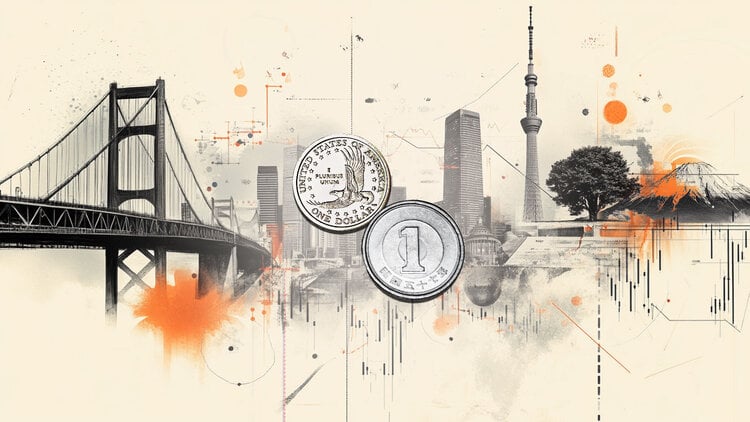- The US Dollar Index advanced to 104.10 points on Thursday.
- February S&P PMI numbers were mixed, while weekly jobless claims were better than expected.
- Strong labor market numbers could push the Fed to remain hawkish.
In Thursday's session, the US Dollar Index (DXY) registered a slight rebound to 104.10, after the publication of mixed data on economic activity and positive figures on the labor market.
Meanwhile, the US Federal Reserve continues to take a firm stance, showing little interest in reducing interest rates soon and emphasizing the importance of keeping them at levels that limit economic overheating. Market sentiment increasingly aligns with this outlook, cementing the expectation that any monetary policy easing will be postponed, which could limit US Dollar losses.
Daily Market Summary: Dollar posts slight gains as markets digest US data
- The US S&P Global Composite PMI fell to 51.4 in February from 52 in January, indicating a slower expansion of business activity in the private sector.
- The S&P Global Manufacturing PMI rose to 51.5 from 50.7, a sign of a slight improvement in manufacturing sector growth.
- The S&P Global services PMI fell to 51.3 from 52.5, reflecting a slowing pace of expansion in the services sector.
- Initial jobless claims for the week ending February 16 stood at 201,000, below the consensus of 218,000.
- Market expectations for the next Fed meeting in March suggest that markets are pricing in a hold, while the odds of a cut also remain low for the May meeting.
- Markets are now pushing the start of interest rate easing to June.
Technical Analysis: DXY bulls struggle to gain more ground and hold below 100-day SMA
The DXY daily chart indicators reflect a mixed picture. The Relative Strength Index (RSI) shows a flat slope, although it remains in positive territory. This suggests that although the buying momentum has slowed recently, the overall uptrend has not completely weakened.
At the same time, the moving average convergence divergence (MACD) is showing red bars, which is another indication of growing selling momentum. This denotes a possible shift towards a sideways trading phase or even a slight bearish reversal.
In a broader context, the DXY is trading above the 20-day SMA and the 200-day SMA, but below the 100-day SMA. This highlights that the bulls maintain some dominance, defying the recent bearish pressure. However, DXY's positioning below the 100-day SMA signals potential short-term unease among buyers.
Even as bulls struggle to gain ground, the overall trend appears to remain in favor of buyers, although growing bearish signals should not be ignored. Therefore, the near-term technical outlook appears to be cautiously bullish, with possible periods of consolidation or minor corrections on the horizon.
US Dollar FAQ
What is the US Dollar?
The United States Dollar (USD) is the official currency of the United States of America, and the “de facto” currency of a significant number of other countries where it is in circulation alongside local banknotes. According to 2022 data, it is the most traded currency in the world, with more than 88% of all global currency exchange operations, equivalent to an average of $6.6 trillion in daily transactions.
After World War II, the USD took over from the pound sterling as the world's reserve currency.
How do the decisions of the Federal Reserve affect the Dollar?
The single most important factor influencing the value of the US Dollar is monetary policy, which is determined by the Federal Reserve (Fed). The Fed has two mandates: achieve price stability (control inflation) and promote full employment. Your main tool to achieve these two objectives is to adjust interest rates.
When prices rise too quickly and inflation exceeds the 2% target set by the Fed, the Fed raises rates, which favors the price of the dollar. When Inflation falls below 2% or the unemployment rate is too high, the Fed can lower interest rates, which weighs on the Dollar.
What is Quantitative Easing and how does it influence the Dollar?
In extreme situations, the Federal Reserve can also print more dollars and enact quantitative easing (QE). QE is the process by which the Fed substantially increases the flow of credit into a clogged financial system. This is an unconventional policy measure used when credit has dried up because banks do not lend to each other (for fear of counterparty default). It is a last resort when a simple lowering of interest rates is unlikely to achieve the necessary result. It was the Fed's weapon of choice to combat the credit crunch that occurred during the Great Financial Crisis of 2008. It involves the Fed printing more dollars and using them to buy US government bonds, primarily from financial institutions. QE usually leads to a weakening of the US Dollar.
What is quantitative tightening and how does it influence the US dollar?
Quantitative tightening (QT) is the reverse process by which the Federal Reserve stops purchasing bonds from financial institutions and does not reinvest the principal of maturing portfolio securities in new purchases. It is usually positive for the US dollar.
Source: Fx Street
I am Joshua Winder, a senior-level journalist and editor at World Stock Market. I specialize in covering news related to the stock market and economic trends. With more than 8 years of experience in this field, I have become an expert in financial reporting.







